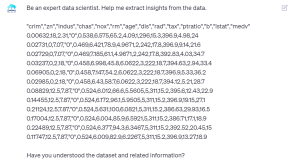
With the explosion of data being generated, data scientists are facing increased pressure to analyze and interpret large amounts of text data effectively. However, this can be a challenging task, especially when dealing with unstructured data. Additionally, data scientists often spend a significant amount of time manually generating text and answering complex questions, which can be a time-consuming process. Welcome ChatGPT! ChatGPT offer a powerful solution to these challenges.
By learning different ChatGPT prompts, data scientists can significantly become super productive while generating relevant insights, answer complex questions, and perform machine learning tasks with ease such as data preprocessing, hypothesis testing, training models, etc. In this blog, I will provide a cheat sheet for data scientists that outlines various ChatGPT prompts along with the information on its output and benefits.
Setting up ChatGPT for Data Science Activities
In order to try some of the prompts mentioned in the next section, you would need to set up ChatGPT by asking it to behave like an expert data scientist and learn the data set that you would be working with for your data science projects. You would be required to share a sample data to you. Thus, the following can be the first prompt after which you can try rest of the prompts mentioned in the next section.
Be an expert data scientist. Help me extract insights from the data.
“crim”,”zn”,”indus”,”chas”,”nox”,”rm”,”age”,”dis”,”rad”,”tax”,”ptratio”,”b”,”lstat”,”medv” 0.00632,18,2.31,”0″,0.538,6.575,65.2,4.09,1,296,15.3,396.9,4.98,24 0.02731,0,7.07,”0″,0.469,6.421,78.9,4.9671,2,242,17.8,396.9,9.14,21.6 0.02729,0,7.07,”0″,0.469,7.185,61.1,4.9671,2,242,17.8,392.83,4.03,34.7 0.03237,0,2.18,”0″,0.458,6.998,45.8,6.0622,3,222,18.7,394.63,2.94,33.4 0.06905,0,2.18,”0″,0.458,7.147,54.2,6.0622,3,222,18.7,396.9,5.33,36.2 0.02985,0,2.18,”0″,0.458,6.43,58.7,6.0622,3,222,18.7,394.12,5.21,28.7 0.08829,12.5,7.87,”0″,0.524,6.012,66.6,5.5605,5,311,15.2,395.6,12.43,22.9 0.14455,12.5,7.87,”0″,0.524,6.172,96.1,5.9505,5,311,15.2,396.9,19.15,27.1 0.21124,12.5,7.87,”0″,0.524,5.631,100,6.0821,5,311,15.2,386.63,29.93,16.5 0.17004,12.5,7.87,”0″,0.524,6.004,85.9,6.5921,5,311,15.2,386.71,17.1,18.9 0.22489,12.5,7.87,”0″,0.524,6.377,94.3,6.3467,5,311,15.2,392.52,20.45,15 0.11747,12.5,7.87,”0″,0.524,6.009,82.9,6.2267,5,311,15.2,396.9,13.27,18.9
Have you understood the dataset and related information?
Data Science Cheat Sheet
The following can be used as a cheat sheet. The table will be updated with more prompts from time-to-time.
| Type | Prompt | Output | Usage |
|---|---|---|---|
| Data Exploration | Give me top 3 insights from the dataset | Three most interesting or important findings from the dataset | Identify key characteristics and trends in the dataset |
| Data Exploration | What hypothesis do you think can be tested from the data given earlier? | A testable hypothesis based on the dataset | Generate hypotheses to guide further analysis or experimentation |
| Hypothesis Testing | Write Python code for performing hypothesis test related to {mention hypothesis test name} | Python code to perform a statistical test as mentioned | Test hypotheses and determine whether there is a significant difference between groups or variables |
| Model Building | Can I build a predictive model using this data? What can I predict? | Whether a predictive model can be built and what can be predicted | Identify the target variable and potential predictors for a predictive model |
| Model Building | Create a Python code for training the model using {machine learning algorithm name} algorithm in which above data can be fed? | Python code to train a model on the dataset using specified {machine learning algorithm}. | Build a regression model to predict a continuous target variable |
| Data Visualization | What Python code can help visualize the relationships existing in the dataset? | Python code to create scatterplots and histograms | Visualize the relationships between variables and explore the distribution of the target variable |
| Data Preprocessing | What preprocessing steps should I perform before building a predictive model? | A list of potential preprocessing steps, such as handling missing values and scaling the features | Prepare the data for building a predictive model |
| Model Evaluation | How can I evaluate the performance of the model? | One or more metrics to measure the performance of a regression model, such as mean squared error (MSE) or R-squared | Determine how well a regression model is able to predict the target variable |
For all of the prompts, you may want to check the following presentation. It has got prompts for the following three topics:
- Exploratory data analysis
- Building predictive models
- Evaluating and selecting models
References
For a detailed understanding and examples, refer to my earlier blog on this topic: ChatGPT for Data Science Projects
Conclusion
The ChatGPT Cheat Sheet for Data Scientists is a valuable resource for anyone looking to optimize their data science & machine learning workflow and become super productive by making the most of their time with ChatGPT. Whether you’re a seasoned pro or just getting started with data science projects, this cheat sheet has something to offer. By implementing these ChatGPT prompts, you’ll be able to get more done in less time, improving your efficiency and productivity as a data scientist. So why wait? Start using the ChatGPT Cheat Sheet today and take your skills to the next level!
- Coefficient of Variation in Regression Modelling: Example - November 9, 2025
- Chunking Strategies for RAG with Examples - November 2, 2025
- RAG Pipeline: 6 Steps for Creating Naive RAG App - November 1, 2025
I found it very helpful. However the differences are not too understandable for me